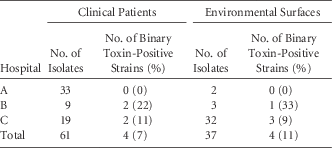To the Editor—Clostridium difficile has been a predominant cause of nosocomial diarrhea in North America and Europe, especially after the emergence of PCR-ribotypes 027 and 078. However, less emphasis is placed on the surveillance and control of C. difficile infection (CDI) in China. Li et alReference Li, Liu and Zhou 1 isolated a novel binary toxin strain of C. difficile from a hospitalized patient and mentioned that cases of ribotype 078 had not previously been reported in China. Here, we report 8 isolates that were identified as C. difficile ribotype 078 in a surveillance program in Zhejiang Province, China.
Our study was conducted at 3 tertiary hospitals (hospitals A, B, and C) from June 2013 to December 2014. A total of 98 unduplicated isolates of C. difficile from 61 clinical patients and 37 environmental surfaces were identified. A multiple polymerase chain reaction (multi-PCR) assay was used to amplify 16S rDNA, tcdA, tcdB, cdtA, and cdtB genes. The overall incidence of binary toxin-positive strains was 8.2%; 4 isolates (7%) were collected from patients, and 4 (11%) isolates were collected from environmental surfaces (Table 1). In hospital B, 2 (22%) of the detected binary toxin strains were obtained from patients and 1 strain (33%) was isolated from an environmental surface. In hospital C, 2 strains (11%) were identified from patients and 3 strains (9%) were obtained from environmental surfaces. No hyper-toxigenic strain was detected in hospital A. According to the tcdC gene sequence, all 8 isolates were identified as ribotype 078, with a mutation point at position 184 and a ∆39-bp deletion (Figure 1).

FIGURE 1 tcdC gene sequences of C. difficile ribotype 078 isolates in the study. A point mutation at position 184 and ∆39-bp deletion compared with wild-type strain VPI 10463 are shown.
TABLE 1 The Incidence of the Binary Toxin-Positive Strains of C. difficile in Three Tertiary Hospitals

Previously, a few Asian countries and regions have reported the emergence of C. difficile ribotype 078, including Kuwait,Reference Rotimi, Jamal and Mokaddas 2 South Korea,Reference Kim, Jeong and Roh 3 Iran,Reference Jalali, Khorvash and Warriner 4 Japan,Reference Senoh, Kato and Fukuda 5 and Taiwan.Reference Lin, Huang and Tsai 6 The present study is the first to identify ribotype 078 cases not only from patients but also from environmental surfaces in China. Compared with neighboring Japan and Korea, the prevalence of CDI in China remains unclear, mainly due to a lack of awareness in the healthcare system.Reference Collins, Hawkey and Riley 7 Many clinicians are accustomed to diagnosing patients with antibiotic-associated diarrhea by experience rather than by the results of stool cultures. In addition, although enzyme-linked immunosorbent assay (ELISA) has been used routinely to detect C. difficile in most tertiary hospitals in China, this method has a low sensitivity and does not trace the binary toxin strain. For these reasons, CDI, especially CDI caused by binary-toxin strains, may be severely underestimated in China.
China has the largest population with the trend of aging accompanied by antibiotic misuse, indicating the potential for epidemics of CDI. Medical practitioners should pay more attention to this global infection, as both C. difficile ribotypes 027 and 078 have been identified in China. Routine fecal culture methods and multicenter surveillance should be introduced in hospitals to estimate the incidence of CDI and to confirm the dominant C. difficile strains in China.
ACKNOWLEDGMENTS
Financial support: This study was supported by a grant from the Hangzhou Science and Technology Bureau (grant no. 20130733Q32).
Potential conflicts of interest: All authors report no conflicts of interest relevant to this article.




